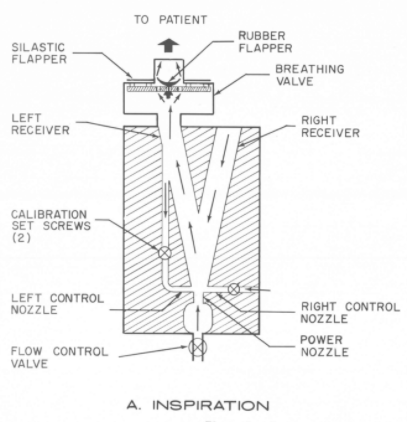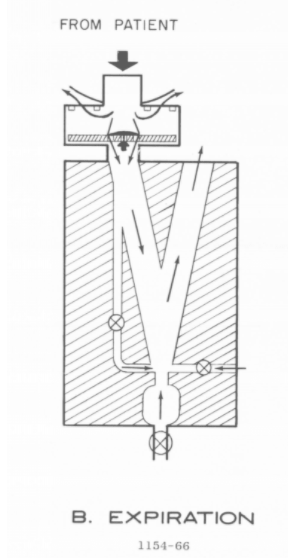This device is just a pressure-controlled switch which directs a high-flow stream of air down one of two channels with a particular timing and min/max pressures. To illustrate, let’s say the pressure stream starts by going to the left in the below diagram, pointing towards the patient (or test lung). Air flows down that channel, building up pressure in the lungs. As it does so, that pressure propagates back to this device and through the left control channel, flowing through it and pushing at the power nozzle. Once enough flow goes through, it’s enough to push the main jet of pressurized air and direct it from the left side (patient side) to the right side (exhalation port). We can control the pressure this happens at by narrowing the channel width – setting the Positive Inspiratory Pressure (or “PIP”). That’s all we need to switch from an inhale to exhale.

Now that the jet is exiting the right channel, the lungs can naturally deflate – and they also get a bit of assistance from entrainment (suction) from all the air rushing out the exhalation port. This continues until the lung pressure is low enough – and thus the pressure on the left control channel is low enough – that there’s a flow from the right to the left across the power nozzle strong enough to push the jet stream back from the right channel to the left – and back to the patients lungs in an inhale. We can control when this exhale ends by narrowing the right channel width via another calibration screw – giving us all we need to make full cycle of inhalation and exhalation at well-defined pressures.

We can change the relative timing of inhalation/exhalation and set the Respiratory Rate by adding resistance (via another screw) on the exhalation port, but that’s all there is to the original 1965 US Army design.
We have subsequently explored many improvements on this design, aiming first and foremost for Positive-End Expiratory Pressure (“PEEP”), as this original design uses a negative pressure. We have found geometries and settings which give comfortable ranges necessary for COVID-19 treatments (PIP 25 cmH2O, PEEP 10 cmH2O, RR 10-20 cpm, TV 350-450 ml) with a stable cycling rate for models of the average patient, and have produced prototypes proving the design works. We are currently working on finalizing our release model which will narrow down the properties into the most usable design we can, which we will then be releasing for testing, regulatory approval, and manufacturing. We ask anyone interested in taking part in this process to reach out to us via the links on this page.
Our final offering will likely be a set of different solid-state single-use disposable models, each designed to treat one particular type of patient (lung volume, compliance, resistance), with clear estimations of tolerance ranges, so medical staff can make informed decisions before prescribing.